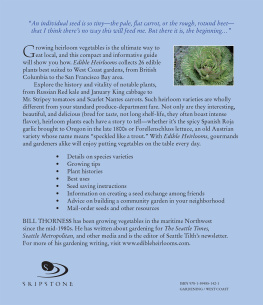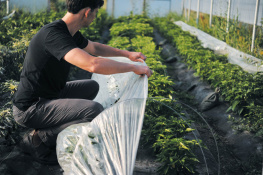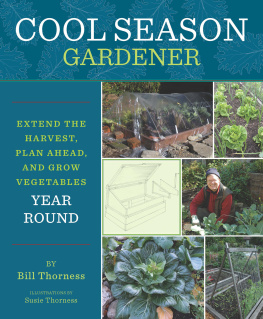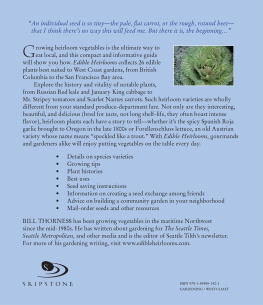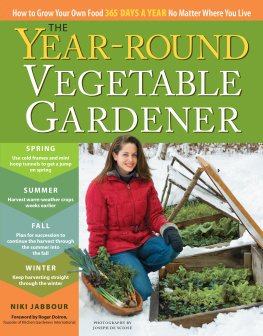
COOL SEASON
GARDENER
COOL SEASON
GARDENER

EXTEND THE
HARVEST,
PLAN AHEAD,
AND GROW
VEGETABLES
YEAR
ROUND
Bill Thorness
ILLUSTRATIONS BY
Susie Thorness

2013 by Bill Thorness
All rights reserved. No part of this book may be reproduced or utilized in any form, or by any electronic, mechanical, or other means, without the prior written permission of the publisher.
Published by Skipstone, an imprint of The Mountaineers Books
Printed in the United States of America
First printing 2013
16 15 14 135 4 3 2 1
Copy Editors: Kris Fulsaas, Leighton Wingate
Design: Jane Jeszeck, www.jigsawseattle.com
Illustrations by Susie Thorness
All photographs by Bill Thorness unless otherwise noted.
ISBN (paperback): 978-1-59485-715-7
ISBN (ebook): 978-1-59485-716-4
Library of Congress Cataloging-in-Publication Data
Thorness, Bill, 1960
Cool season gardener : extend the harvest, plan ahead, and grow vegetables year-round / Bill Thorness ;
illustrations by Susie Thorness. 1st ed.
p. cm.
Includes index.
ISBN 978-1-59485-715-7 (ppb)
1. Vegetable gardeningNorthwest, Pacific. I. Title.
SB321.5.N58T46 2013
635dc23
2012041688
Skipstone books may be purchased for corporate, educational, or other promotional sales.
For special discounts and information, contact our sales department at 800.553.4453 or
.
Skipstone
1001 SW Klickitat Way
Suite 201
Seattle, Washington 98134
206.223.6303
www.skipstonebooks.org
Contents
The seed is in the ground.
Now we may rest in hope while
darkness does its work.
Wendell Berry, 1991, V,
A Timbered Choir
Acknowledgments
This book did not germinate, sprout, and bloom from the efforts of just one gardener. First and foremost, it was made possible through the collective wisdom provided by many people over two decades of community and home gardening. Thanks go to all my garden mentors, both intentional educators and good old over-the-back-fence advisors. Among a large community of gardening friends, they are Julie Bryan, Sarah Cassidy, Carl Elliott, Arthur Lee Jacobson, Joanne Jewell, Josh Kirschenbaum, Rob Peterson, Howard Stenn, Ian Taylor, Lisa Taylor, and Carl Woestwin.
Im also indebted to the books of Suzanne Ashworth, Linda Chalker-Scott, Binda Colebrook, Eliot Coleman, Rosalind Creasy, John Jeavons, William Head, and Steve Solomon; please see the Resources section for titles of their very useful books. The Miller Library at the University of Washingtons Center for Urban Horticulture was invaluable, as was expert input from the instructors in the Master Gardener program operated by Washington State University/King County Extension.
Reviewers, sources, and consultants included Betty Barker, Doug Collins, Colleen Lochovich, Cliff Mass, Vern Nelson, Amy Ocherlander, Doug Oster, Kristy Ott-Borrelli, and Charley and Carol Yaw. My essential resource on anything having to do with building is journeyman carpenter and great friend Tim Olson. My first reader, cherished advisor, and wonderful illustrator is Susie Thorness. My expert editing collaborator, who always makes my work so much better, is Kris Fulsaas. I also am indebted to the excellent work and support of The Mountaineers Books and Skipstone staff and freelance contractors. Although these folks and others generously helped make this book better, I am solely responsible if it falls short of its goal or contains any incorrect information.
For my productive garden, and for the educational mulch that nourished this book, I offer heartfelt appreciation.

Introduction
Growing our own food is a delightful, productive pastime. Working with nature to cultivate edible plants from bare soil and a handful of seeds can be as nourishing to the spirit as it is to the body. The act of gardening, its many activities and chores, can strengthen and maintain a persons health. Of course, eating the fresh, organic food that we grow provides nutrition and much satisfaction.
So, if growing edibles is such a useful experience, why let it drop for three to six months each year? In some areas, the climate makes that choice for gardeners; it is just too cold for plants to grow, or the landscape is covered in snow. But in other areas, such as the maritime Northwest, the winter climate can be hospitable to the food gardener, and the garden can provide nourishment year-round. Why not try it?
To become a cool-season vegetable gardener requires a bit more planning and education, but under the right weather conditions, it is not a difficult task. It starts with the will to do it and a garden that gets good winter light. Add insulated gloves, a few specialized contraptions, targeted techniques, and some extra planning. Many people build or buy garden structures that extend the growing seasons by protecting plants from the harshest side of winter. They also employ proper timing and planting techniques, and take into consideration what grows well in a mild maritime climate. Because these tools and techniques are not given much attention in most gardening literature, this book attempts to tackle them in-depth.
Through a year-round lens, well look at the groundwork involved in gardening: enhancing your site and soil, understanding the weather, and getting your edible plants off to a good start. Then we will tackle those specialized cool-season methods and skills: expanding the growing calendar to seven mini-seasons, considering succession plans and maturity dates, and learning how to make and use many season-extending devices. The book also provides a listing of favorite cool-season vegetables, including suggested varieties, and a plethora of resources to help with the process.
Cool-season gardening actually begins in summer, when its necessary to plan ahead and start some fall and winter vegetables while the weather is warm. By late fall, the kitchen garden can produce a variety of delectable edibles. Expanding vegetable gardening to year-round production means you can serve up your own glorious green salad at Thanksgiving, robust beets at the winter solstice, fresh-picked leeks at New Years, tender broccoli for Valentines Day, and homegrown carrots on St. Patricks Day.
A mild winter climate offers the chance to put garden-fresh food on your tableand feed your spirit by regularly communing with nature in your garden. And its a way to get more productivity from your land. Growing food through all four seasons is like tripling the amount of space you have to garden.
But for me, gardening year-round means more than food in the garden, it also means I am growing with it. As I walk the paths daily, I learn from the seasons, lessons that radiate into other aspects of my life. Feeling the pace of the natural world teaches me patience or quickens my pulse. Watching and interacting with the web of life that exists from soil to sky provides perspective on my place in the system. Experiencing so much from my garden makes me want to just keep the cycle going, and growing, and growing
Next page

